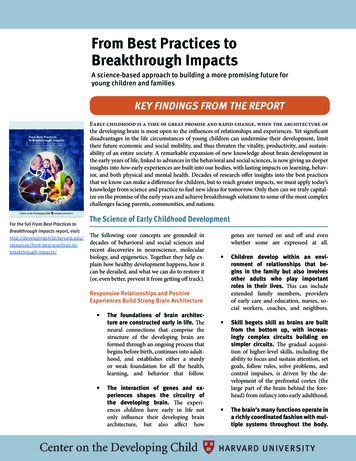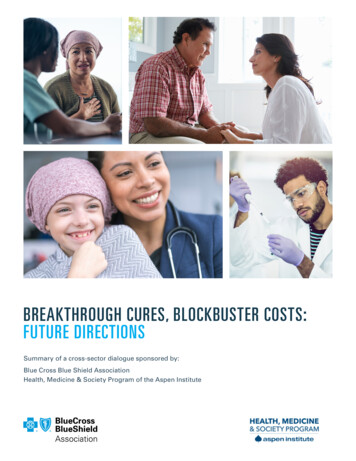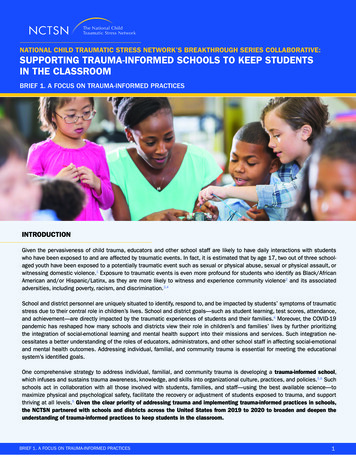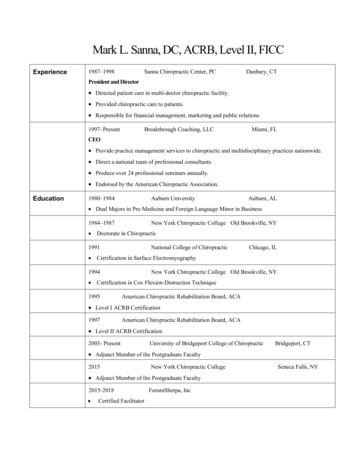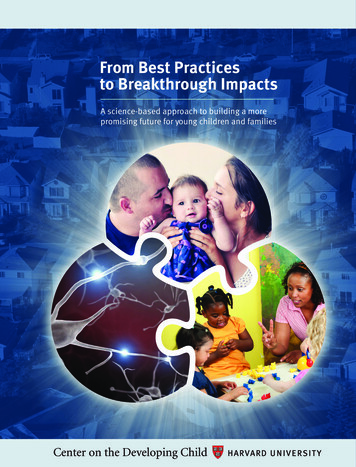
Transcription
From Best Practicesto Breakthrough ImpactsA science-based approach to building a morepromising future for young children and families
NATIONAL SCIENTIFIC COUNCIL ON THE DEVELOPING CHILDCOUNCIL MEMBERSMAJOR FUNDINGSUPPORTBuffett Early ChildhoodFundThe JPB FoundationBezos Family FoundationPalix FoundationAlliance for Early SuccessDoris Duke CharitableFoundationOmidyar NetworkHemera FoundationAnnie E. CaseyFoundationRobert Wood JohnsonFoundationBill & Melinda GatesFoundationJack P. Shonkoff, M.D., ChairJulius B. Richmond FAMRI Professor of Child Health andDevelopment, Harvard T.H. Chan School of Public Healthand Harvard Graduate School of Education; Professorof Pediatrics, Harvard Medical School and BostonChildren's Hospital; Director, Center on the DevelopingChild at Harvard UniversityPat Levitt, Ph.D., Science Co-DirectorSimms/Mann Chair in Developmental Neurogenetics,Institute for the Developing Mind, Children's HospitalLos Angeles; W. M. Keck Provost Professor inNeurogenetics, Keck School of Medicine, University ofSouthern CaliforniaNathan A. Fox, Ph.D., Science Co-DirectorDistinguished University Professor; Director, ChildDevelopment Laboratory, University of Maryland CollegeParkSilvia A. Bunge, Ph.D.Professor, Department of Psychology & Helen WillsNeuroscience Institute, University of California, BerkeleyJudy L. Cameron, Ph.D.Professor of Psychiatry, Neuroscience, ObstetricsGynecology Reproductive Sciences, and Clinical andTranslational Science, University of Pittsburgh; Directorof Outreach, School of Medicine, University of PittsburghGreg J. Duncan, Ph.D.Distinguished Professor, Department of Education,University of California, IrvinePhilip A. Fisher, Ph.D.Philip H. Knight Chair; Professor of Psychology,University of Oregon; Senior Scientist, Oregon SocialLearning Center; Director of Translational Science,Center on the Developing Child at Harvard UniversityMegan R. Gunnar, Ph.D.Regents Professor and Distinguished McKnightUniversity Professor, Institute of Child Development,University of MinnesotaTakao Hensch, Ph.D.Professor of Molecular and Cellular Biology, HarvardFaculty of Arts and Sciences; Professor of Neurology,Harvard Medical School at Children’s HospitalFernando D. Martinez, M.D.Regents' Professor; Director of the Arizona RespiratoryCenter; Director of the BIO5 Institute; Director of theClinical and Translational Science Institute; SwiftMcNear Professor of Pediatrics, University of ArizonaBruce S. McEwen, Ph.D.Alfred E. Mirsky Professor; Head, Harold and MargaretMilliken Hatch Laboratory of Neuroendocrinology; TheRockefeller UniversityCharles A. Nelson III, Ph.D.Professor of Pediatrics and Neuroscience, HarvardMedical School; Professor of Education, HarvardUniversity; Richard David Scott Chair in PediatricDevelopmental Medicine Research, Boston Children'sHospitalNATIONAL FORUM ON EARLY CHILDHOOD POLICY AND PROGRAMSFORUM MEMBERSJack P. Shonkoff, M.D., ChairJulius B. Richmond FAMRI Professor of Child Health andDevelopment, Harvard T.H. Chan School of Public Healthand Harvard Graduate School of Education; Professorof Pediatrics, Harvard Medical School and BostonChildren's Hospital; Director, Center on the DevelopingChild at Harvard UniversityGreg J. Duncan, Ph.D.Distinguished Professor, Department of Education,University of California, IrvinePhilip A. Fisher, Ph.D.Philip H. Knight Chair; Professor of Psychology,University of Oregon; Senior Scientist, Oregon SocialLearning Center; Director of Translational Science,Center on the Developing Child at Harvard UniversityKatherine Magnuson, Ph.D.Professor of Social Work, University of Wisconsin,MadisonHirokazu Yoshikawa, Ph.D.Courtney Sale Ross University Professor of Globalizationand Education, Steinhardt School of Culture, Education,and Human Development, New York University;University Professor, New York University; Co-Director,Global TIES for Children CenterFORUM ASSOCIATEHolly Schindler, Ph.D.Assistant Professor, Early Childhood and Family Studies,Educational Psychology, University of Washington
ContentsFrom Best Practices to Breakthrough ImpactsINT RODUCTION: CRAF TING A ROADMAP TO BET TER OUTCOMESCHAPTER 1: THE SCIENCE OF EARLY CHILDHOOD DEVELOPMENT . . . . . . . . . . . . . . . 4. . . . . . . . . . . . . .7CHAPTER 2: LESSONS LEARNED FROM FIVE DEC ADES OF PROGRAMEVALUATION RESEARCH . . . . . . . . . . . . . . . . . . . . . . . . . . . . . . . . . . . . . . . .19CHAPTER 3: CREATING AN R&D ENGINE TO PRODUCE BREAKTHROUGH. . . . . . . . . . . . . . . . . . . . . . . . . . . . . . . . . . . . . . . . . . .31. . . . . . . . . . . . . . . . . . . . . . . . . . . . . . . . . . . . . . . . . . . . . . . . . . . .41IMPACTS AT SC ALE .A C ALL TO ACTION .REFERENCES . . . . . . . . . . . . . . . . . . . . . . . . . . . . . . . . . . . . . . . . . . . . . . . . . . . . . . . . . .42ACKNOWLEDGEMENTSThe Center on the Developing Child gratefully acknowledges the numerous people who helped to shape our learningover the past several years and who provided specific comments on this report, as well as the growing Frontiersof Innovation community that provides continuous inspiration and shows us firsthand how to co-create, learn aswe go, and scale our work. We also thank the FrameWorks Institute for their enduring partnership and research oncommunicating the science of child development.Illustrations (pages 13, 21, 26, 28, 32, 34) by Ernesto D. MoralesSuggested citation: Center on the Developing Child at Harvard University (2016). From Best Practices to Breakthrough Impacts:A Science-Based Approach to Building a More Promising Future for Young Children and Families.http://www.developingchild.harvard.edu May 2016, Center on the Developing Child at Harvard UniversityThe Center on the Developing Child’s mission is to drive science-based innovation that achieves breakthrough outcomes for childrenfacing adversity. We believe that advances in science provide a powerful source of new ideas focused on the early years of life. Founded in 2006, the Center catalyzes local, national, and international innovation in policy and practice focused on children and families.We design, test, and implement these ideas in collaboration with a broad network of research, practice, policy, community, and philanthropic leaders. Together, we seek transformational impacts on lifelong learning, behavior, and both physical and mental health.
CENTER ON THE DEVELOPING CHILD AT HARVARD UNIVERSITYCrafting a Roadmap to Better OutcomesEarly childhood is a time of great promise and rapid change, when the architecture ofthe developing brain is most open to the influence of relationships and experiences. Yet, at the sametime, significant disadvantages in the life circumstances of young children can undermine theirdevelopment, limit their future economic and social mobility, and thus threaten the vitality, productivity, and sustainability of an entire country. A remarkable expansion of new knowledge about braindevelopment in the early years of life, linked to advances in the behavioral and social sciences, is nowgiving us deeper insights into how early experiences are built into our bodies, with lasting impacts onlearning, behavior, and both physical and mental health. These insights can be used to fuel new ideasthat capitalize on the promise of the early years and lead to breakthrough solutions to some of themost complex challenges facing parents, communities, and nations.Half a century of program evaluation researchhas demonstrated repeatedly that effective earlychildhood services can improve life outcomesfor children facing adversity, produce importantbenefits for society, and generate positive returnson investments. Policymakers and practitionersoften invoke this evidence base to build supportfor existing programs, but the average magnitude of intervention effects has not increasedsubstantially in 50 years, while the challengesmost current programs were originally designedto address have become even more complex.During this same period, scientific understanding of the early origins of lifelong health anddevelopment has been advancing rapidly. Thesediscoveries offer a compelling opportunity togenerate creative, new approaches to problemsthat are not being resolved by existing services.The time has now come to raise the bar and leverage the frontiers of 21st-century science topursue a bolder vision.Fifty years ago, a high school diploma created apathway to the middle class in the United States;the same cannot be said today.The world as it existed in the 1960s, whenmany current child and family policies and programs were created, has changed dramatically.Arguably the most relevant of these changes forfamilies with young children facing adversityhas been the decreasing opportunity for peopleat the lower end of the socioeconomic spectrumto improve their financial circumstances, withinand across generations. Massive global labormarket restructuring, for example, makes it increasingly difficult for workers with low levelsof skills to support a family and stay employed.Fifty years ago, a high school diploma created apathway to the middle class in the United States;the same cannot be said today.Over this same period, racial gaps in educational achievement have decreased, and both testscores and graduation rates for children in lowincome families have moved upward, but thelargest gains have been documented for childrenin the most economically advantaged families.¹Thus, disparities in achievement have grownwider not because early childhood programshave had no impact, but because the size of theireffects has failed to keep pace with the benefitsof growing up in a high-income family in a rapidly changing world.Social class differences in population healthalso begin early and lead to significant costs tosociety. Adult health impairments in the UnitedStates that are disproportionately associatedwith adverse childhood experiences include manyof the most costly, led by 96.5 billion in directmedical care expenses annually for cardiovasculardisease and 86 billion for mental health disorders.² Globally, although child mortality rates inmany low- and middle-income countries havedecreased dramatically in recent decades, about4 From Best Practices to Breakthrough Impacts www.developingchild.harvard.edu
CRAFTING A ROADMAP TO BETTER OUTCOMESone-third of children under age 5 fail to meettheir developmental potential as a result of poverty and inadequate nutrition.³In addition to the effects of global macroeconomic forces, multiple social patterns andlife circumstances influence the life prospectsof young children in the United States. To namejust a few: Changes in family structure and stability, such as an increase in single-parenthouseholds, affect the ability of manyparents to provide consistent social andfinancial security for young children.⁴ Delaying the birth of a first child has beenshown to contribute to greater economicopportunity, yet women in poverty haveless access to effective means of planning pregnancies and disproportionatelyhigher rates of unanticipated pregnanciesthan women with higher income.⁵ Mounting evidence indicates that repeatedexperiences of racial or ethnic discrimination are associated with increased riskof a multitude of stress-related illnessesacross the lifespan.⁶Advances in neuroscience, molecular biology,and epigenetics offer an unprecedented opportunity to stimulate new responses to these complexsocial, economic, and political challenges byexplaining why young children facing adversityare more likely to have disrupted developmentaltrajectories.7-9 Neuroscience is also producingextensive evidence suggesting that the later wewait to support families with children who are atgreatest risk, the more difficult (and likely morecostly) it will be to achieve positive outcomes,particularly for those who experience the biological disruptions of toxic stress during the earliestyears.10,11 More specifically, at a time when thediscourse around early childhood investments isdominated by debates over preschool for 4-yearolds, the biological sciences cry out for attendingto a missing niche in the field—new strategies inthe prenatal-to-three period for families facingadversity.While proposed solutions to these social andeconomic challenges fuel hotly contested partisan debates, knowledge about the foundationsof healthy development is politically neutral andclear—whatever the source of the adversity, experiencing too much of it early in life withoutadequate support from adult caregivers (bothinside and outside the home) is detrimental tochild well-being. Although the full consequencesof family structure, labor market transformations, K-16 education reform, and the cumulativetoll of stress caused by discrimination and othersocial disadvantages all require serious attention, a deeper analysis of these issues is beyondthe scope of this report. Instead, we present aresearch and development (R&D) approach thattranscends partisan disagreement because it isbuilt on a rigorously peer-reviewed, sciencebased understanding of how the foundationsof learning, behavior, and health are built orweakened over time.sciences cry out for attending to a missing niche inwww.developingchild.harvard.eduAt a time when the discourse around earlychildhood investments is dominated by debatesover preschool for 4-year-olds, the biologicalthe field—new strategies in the prenatal-to-threeperiod for families facing adversity.The call for fresh thinking and new ideasgrounded in rigorous science that is presentedthroughout this document is driven by a thoughtful examination of the current environment inwhich policy and practice are conducted. Onthe one hand, many leaders in the field are engaged in critically important efforts to improvethe quality of programs, increase the effectiveness and efficiency of service delivery systems,enhance the skills and compensation of a highlydiverse early childhood workforce, and encourage innovation. These efforts are happening atmultiple levels across a variety of sectors—andthey must be sustained. On the other hand,most decision makers urge funding solely forFrom Best Practices to Breakthrough Impacts 5
CENTER ON THE DEVELOPING CHILD AT HARVARD UNIVERSITYprograms with previously demonstrated effectiveness, regardless of the nature or magnitudeof their impacts. This widespread preference for“evidence-based” programs, many of which haveproduced small effects on random categories ofoutcomes that have not been replicated, seriously limits the likelihood of achieving increasingly larger impacts at scale over time. Indeed,many of the most compelling challenges facingthe early childhood field today are linked to theabsence of sufficient professional and politicalincentives for developing and testing new ideas.The creation of this document has been drivenby an intensive review process by the NationalScientific Council on the Developing Child andthe National Forum on Early Childhood Policyand Programs to assure the credibility of itsscientific content. Over the past 12 years, theCouncil’s ongoing work to bring science to bearon public policies for young children has resultedin a series of 13 working papers that continuesto grow. Chapter one of this report consolidateskey concepts from the entire series into one cohesive story of early childhood and early braindevelopment.We believe that dramatic improvements in lifelonglearning, behavior, and health are not onlyachievable but also absolutely essential for athriving and sustainable society.The Forum has built an extensive database incorporating 47 years of program evaluation dataand conducted multiple meta-analyses, alongwith examining other literature reviews, allaimed at answering important questions aboutearly childhood program impacts and effectiveness factors. Drawing on this massive knowledgebase, chapter two of the report distills five coreprinciples that can guide decisions about how toimprove the quality of existing programs and increase their return on investment. Although theevidence base reviewed in this chapter focusesprimarily on programs that provide direct services for young children and their parents, weacknowledge the comparable need for scienceinformed innovation at the neighborhood, systems, and policy levels, including investmentsin housing, income support, and job training,among many other domains of influence onchild well-being.Chapter three builds on the first two and proposes an approach to answering the followingquestion: “How can we do better?” Shaped bythe growing Frontiers of Innovation community, it is inspired by the conviction that achieving significantly greater impacts on the lives ofyoung children facing adversity will require amore creative approach to investment that invitesnew ideas, supports responsible risk-taking, demands more rigorous measurement and evaluation, and learns from failure. Decades ofresearch in developmental psychology, neurobiology, and implementation science provide arich knowledge base to catalyze such creativity—and the transition into a new (and substantiallymore effective) era in early childhood policy andpractice will be led by those who view currentbest practices at multiple levels as a vital startingpoint, but not a final destination.We invite all who share this sense of constructive dissatisfaction with the status quo—whetherfrom the worlds of policy, practice, research,philanthropy, or those who simply want to maketheir communities a better place for children—tojoin us on a journey of discovery in an effort tocreate a new era in early childhood investment.Our goal is nothing less than breakthrough impacts for children facing adversity. We believethat dramatic improvements in lifelong learning,behavior, and health are not only achievable butalso absolutely essential for a thriving and sustainable society. Leveraging what we are learningfrom science to generate and test new ideas is acritical, untapped key to unlocking these dramatic improvements.6 From Best Practices to Breakthrough Impacts www.developingchild.harvard.edu
THE SCIENCE OF EARLY CHILDHOOD DEVELOPMENTThe Science of Early Childhood DevelopmentThe capacities developed during childhood are the building blocks of a well-functioning,prosperous, and sustainable society, from positive school achievement and economic self-sufficiency to1responsible adult behavior and lifelong health. When we give children today what they need to learn,develop, and thrive, they give back to society in the future through a lifetime of productive citizenship.Building on a well-established knowledge base more than half a century in the making, recent advances inthe science of early childhood development and its underlying biology provide a deeper understandingthat can inform and improve existing policy and practice, as well as help generate new ways of thinking about solutions. The following core concepts are grounded in decades of behavioral and social sciences and recent discoveries in neuroscience, molecular biology, and epigenetics. Together they helpexplain how healthy development happens, what can send it off track, and what we can do to restore it.Responsive Relationships and Positive Experiences Build Strong BrainArchitectureBrains are built over time, and the foundations of brain architecture are constructedearly in life. The neural connections that comprisethe structure of the developing brain are formedthrough an ongoing process that begins beforebirth, continues into adulthood, and establisheseither a sturdy or weak foundation for all thehealth, learning, and behavior that follow.During the first few years after birth, morethan 1 million new synapses (connections betweenneurons) form every second.12,13 After a periodof rapid proliferation, these connections are reduced through a normal process called pruning,which enables remaining brain circuits to become stronger and more efficient. Early experiences affect the nature and quality of the brain’sdeveloping architecture by determining whichcircuits are reinforced and which are prunedthrough lack of use. Some people refer to this as“use it or lose it.”Just as in the construction of a house, certain parts of the developing brain must be builtin a predictable sequence and what is built earlymust be strong enough to support the longterm structure. And, just as the unavailabilityof needed materials at key points in the processcan force changes to blueprints, the lack of appropriate experiences can lead to alterationsin neural architecture. Moreover, although thewww.developingchild.harvard.edubrain retains the capacity to adapt and changethroughout life, this capacity decreases with age.Thus, building more advanced cognitive, social,and emotional skills on a weak foundation isfar more difficult and less effective than gettingthings right from the beginning.14-17The exceptionally strong influence of early experiences on brain architecture makes the earlyyears a period of both great opportunity andgreat vulnerability for development. A growthpromoting environment that provides adequatenutrients, is free of toxins, and is rich in socialinteractions with responsive caregivers preparesthe developing brain to function well in a rangeof circumstances. An adverse environment inwhich young children are not well-nourished,are exposed to toxic substances, and/or are deprived of appropriate sensory, emotional, andsocial experiences is likely to disrupt the construction of important foundational capacities.Once established, a weak foundation can havedetrimental effects on further brain development, even if a healthy environment is restoredat a later age.The interaction of genes and experiencesshapes the circuitry of the developing brain.Scientists have discovered that the experienceschildren have early in life—and the environments in which they have them—not only shapeFrom Best Practices to Breakthrough Impacts 7
CENTER ON THE DEVELOPING CHILD AT HARVARD UNIVERSITYtheir developing brain architecture, but also affect how genes are turned on and off and evenwhether some are expressed at all.The old ideas that genes are “set in stone” orthat they alone determine developmental outcomeshave been fully disproven. It is more accurate tothink about genes as packages of biological instructions that require an authorizing signatureto be carried out. Both positive experiences,such as rich learning opportunities, and negative influences, such as exposure to stressful lifecircumstances or environmental toxins, leave a“chemical signature” on the genes. These signatures can range from temporary to permanent,but all affect how easily the genes are switchedon or off.8,18,19Building more advanced cognitive, social, andemotional skills on a weak foundation is farmore difficult and less effective than gettingthings right from the beginning.This phenomenon is known as “epigeneticadaptation” and it shapes how our brains and bodies develop. Epigenetic influences are one of thebiological mechanisms through which the environment of relationships, the physical, chemical, andbuilt environment, and early nutrition all get“under the skin” and influence lifelong learning, behavior, and health.20 In work that hasimportant implications for providing appropriate prenatal experiences and adequate nutritionfor expectant mothers, research in both animalsand humans now shows that some epigeneticchanges can occur during pregnancy. In fact,some can actually be passed on to later generations, thereby affecting the health and wellbeing of children, grandchildren, and even theirdescendants.21-23Supportive environments and rich learningexperiences generate epigenetic signatures thatactivate positive genetic potential.24 Early stimulation of the brain through active use of learningand memory circuits can thus result in epigenetic changes that establish a foundation for more8effective learning capacities in the future.25,26 Onthe other hand, highly stressful early experiencescan authorize genetic instructions that disruptthe development of systems that manage responses to adversity later in life.18,19,27Children develop within an environment ofrelationships that begins in the family but alsoinvolves other adults who play important rolesin their lives. This can include extended familymembers, providers of early care and education,nurses, social workers, coaches, and neighbors.These relationships affect virtually all aspectsof development—intellectual, social, emotional,physical, and behavioral—and their quality andstability in the early years lay the foundation thatsupports a wide range of later outcomes.15,29-33These outcomes include self-confidence andsound mental health, motivation to learn,achievement in school and later in the workplace, the ability to control aggressive impulsesand resolve conflicts in nonviolent ways, behaviors that affect physical health risks, and thecapacity to develop and sustain friendships andclose relationships and ultimately become a successful parent.34Children’s experiences with all of the peoplewho are consistently in their lives have an important influence on their brain structure andfunction. This developmental process is fueledby reciprocal, “serve and return” interactionsbetween children and the adults who care forthem. Young children naturally reach out for interaction through babbling, facial expressions,gestures, and words, and adults who are responsive return these serves with similar vocalizing, gesturing, and emotional engagement. Thisserve and return behavior continues like a gameof tennis or passing a ball back and forth. If theadult’s responses are unreliable, inappropriate,or simply absent, the architecture of the child’sdeveloping brain may be disrupted, and laterlearning, behavior, and health may be impaired.Young children and parents both can initiate andrespond in this ongoing process.14,32,35-40These reciprocal and dynamic interactions areessential for healthy development and literallyshape the architecture of the developing brain.From Best Practices to Breakthrough Impacts www.developingchild.harvard.edu
THE SCIENCE OF EARLY CHILDHOOD DEVELOPMENTThey provide what nothing else in the world canoffer—experiences that are individualized to thechild’s unique personality style, that build on hisor her own interests, capabilities, and initiative,that shape the child’s self-awareness, and thatstimulate the child’s growth and development.Skill begets skill as brains are built fromthe bottom up, with increasingly complexcircuits building on simpler circuits, andincreasingly complex and adaptive skillsemerging over time.41-43 Times of exceptionalsensitivity to the effects of environment andexperience for different brain circuits are calledcritical or sensitive periods.Sensitive periods begin and end at differentages for different parts of the brain. For example,the sensitive periods for neural circuits relatedto vision, hearing, and touch tend to end in thefirst years of life.44,45 In contrast, the sensitive periods for circuits that process more complex aspects of the world, such as communication, theinterpretation of facial expressions, reasoning,and decision-making, all end later in development.46-48 Because circuits mature sequentially,different kinds of experiences are critical at different ages.49 Soon after birth, basic sensory,social, and emotional experiences are essentialfor optimizing the architecture of low-level circuits, and at later ages, more sophisticated kindsof learning opportunities are critical for shapinghigher-level circuits.It is vitally important that experiences provided in the earliest years are appropriate for thechild’s stage of development. Encouraging selfdirected, creative play is one important strategyfor supporting that goal. Indeed, the key dimensions of play are precisely those that fuel the development of increasing capabilities as a childgets older by promoting a state of low anxietyand providing opportunities for novel experiences, active engagement, and learning frompeers and adults.Reading a picture book with a toddler who islearning to speak offers another example of ageappropriate skill-building by providing an important opportunity to point to and talk aboutthe pictures, rather than focusing on the writtenwww.developingchild.harvard.eduwords. The ability to decode written languagecomes later, when the appropriate, higher-levelbrain circuitry is being built. If adults ask youngchildren to master skills for which the necessarybrain circuits have not yet been formed—such asprograms that attempt to drill toddlers in reading or math facts—they will be wasting time andresources, and might even impair healthy braindevelopment if they induce excessive stress inthe child.Serve and return interactions shape brain architecture. When an infant or youngchild babbles, gestures, or cries, and an adult responds appropriately with eyecontact, words, or a hug, neural connections are built and strengthened in thechild’s brain that support the development of communication and social skills.For the developing brain, this means that theabilities to perceive simple aspects of the worldand to make simple emotional and social judgments develop long before the ability to carefullyweigh multiple factors during reasoning anddecision-making tasks.50,51 The gradual acquisition of higher-level skills, including the abilityto focus and sustain attention, set goals, followrules, solve problems, and control impulses, isdriven by the development of the prefrontal cortex(the large part of the brain behind the forehead)from infancy into early adulthood.52-55 A significant part of the formative development of theprefrontal cortex occurs during early childhood,as critic
that capitalize on the promise of the early years and lead to breakthrough solutions to some of the most complex challenges facing parents, communities, and nations. 4 From Best Practices to Breakthrough Impacts www.developingchild.harvard.edu Fifty years ago, a high school diploma created a

